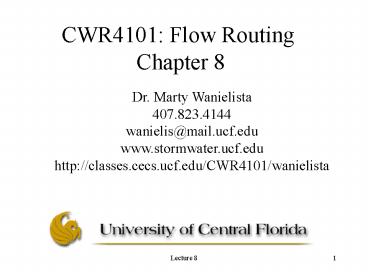CWR4101: Flow Routing Chapter 8 PowerPoint PPT Presentation
1 / 15
Title: CWR4101: Flow Routing Chapter 8
1
CWR4101 Flow Routing Chapter 8
Dr. Marty Wanielista 407.823.4144 wanielis_at_mail.uc
f.edu www.stormwater.ucf.edu http//classes.cecs.u
cf.edu/CWR4101/wanielista
2
Outline Classifications for Routing
- Hydraulic - Based on momentum and continuity
equations, also called the St. Venant equations. - 1. Can be solved using finite difference
equations for known channel geometries. - 2. The basic form of the kinematic wave
equations are 8.8 and 8.10. (section 8.2) - Hydrologic - Based primarily on a mass balance.
- 1. Inventory Equations (section 8.3)
- 2. Muskingum Method (section 8.4)
- Computer Programs, SMADA, ICPR, HEC1 and others.
3
Why? Pond Design and Flow Predictions or
Hydrograph Shapes after Storage
Influent Hydrograph
Discharge or Effluent Hydrographs
4
Applications to Systems of flow
- Watersheds have different characteristics, such
as, slopes, impervious cover, soils, flow paths,
etc, thus separate ID is necessary - Many river or estuary sections require an
estimate of flows downstream - Many decision points for peak discharges, volume,
and low flows (MFLs) - See handout from HEC 1 Users Manual
5
How to keep track of the system? Use A Watershed
Schematic
- Hydrograph Generation
- Analysis Point
- Detention Pond, River Segment, or Reservoir
See handout for discussion
6
Hydraulic Routing
- Momentum Equation
- Continuity Equation QAV
Equation 8.1
Equation 8.2
7
Kinematic Wave
- Using Continuity
- Q a Am
- where aand m are kinematic wave constants.
- To solve use differential form of equation 8.2
- dA/dt amA(m-1)dA/dx q (unit flow) (8.5)
- Let dA/dx DA/Dx (Ai,j-1 Ai-1,j-1)/Dx
- Or solve by finite differences. (8.8,8.9,8.10)
- And average velocity (celerity) am(Aavg)m-1
(8.13) - Which must be less than Dx/Dt and L/2 ltDxgtL/50
8
Kinematic Wave Overland Flowfor unit width flow
qo
- qo (1.486/N)So1/2yo5/3 o is overland flow
- Also qo aoyomo
- So ao (1.486 So1/2 /N) and mo 5/3
- See page 309 for other sections and
- Example problem 8.1, pages 310-313.
9
Hydrologic Modeling
- Mass Balanced Based
- Must have relationships between storage and
discharge or among storage stage and discharge. - Widely applied
- Found in most computer algorithms
10
Mass Balanced Based
- Given an input to a watershed, stream or pond,
what is the output
11
Inventory Equations (volume)
- Storage Change Inflow Outflow
- S0 Inflow1 Outflow1 S1
- S1 Inflow2 Outflow2 S2
- S2 S1 I2 O2 and Si Si-1 Ii Oi
- Si - Si-1 (Ii Ii-1)/2 (Oi Oi-1)/2
- However, two unknows, Si Oi
- Thus we need another equation, a
- Stage storage discharge relationship O vs S
12
Working Equations - flow rate time
- Mass Balance per time step Equation
- Known Equations (all known numbers on one side
of the equation) - Let Iavg (Ii Ii-1)/2 and Ni is a state
variable - Ni Si Oi/2Dt Si-1 Oi-1/2Dt
Iavg Dt - NOTE Still two unknows Si and Oi
13
Stage Storage Discharge Relationship
- S- O relationship
- O (S S_at_O0)/slope and Sslope(O) S_at_O0
- Known Equations substituting with the S-O
equation
O cfs
N slope(O) S_at_O0 O/2Dt and N slope
Dt/2 O S_at_O0 Do Example Problem 8.2 Page
315-317
1
slope
S CF
S_at_O0
14
Muskingum Method
- Application to river systems
- Postulate
- S cSI (1-c)SO where c is a weighting factor
lt 0.5 - and SO is outflow and SI is inflow
- Must also have relationships between Discharge
and stage and between Storage and stage (depth),
given as - O ayn and S bym
- where a,b,n, and m are specific for a river
reach. - See pages 322-329
15
End Flow Routing, Chapter 8
Dr. Marty Wanielista 407.823.4144 wanielis_at_mail.
ucf.edu www.stormwater.ucf.edu http//classes.cec
s.ucf.edu/CWR4101/wanielista

